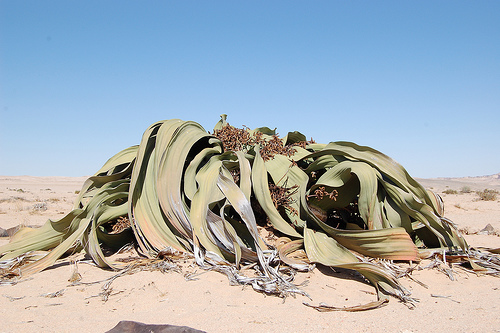Tree tumbos are true desert plants.
- Tree tumbos are a species of large plant native to the Namib Desert of southern Africa, and due to their dry and lifeless appearance, they are commonly considered the ugliest plant alive.
- A ‘tree tumbo’ is also known as ‘welwitschia’; in Angola it is named ‘n’tumbo’, meaning ‘stump’; in South Africa it is called “twee blaar kanniedood’, and has the literal translation of ‘two leaf diehard’; and the plant is known as ‘onyanga’, a term meaning ‘desert onion’ in the Herero language.
- The scientific name of a tree tumbo is Welwitschia mirabilis and it is from the family Welwitschiaceae, with the plant being the sole extant species in the family.
- Tree tumbos only grow two leaves, that can reach a length of 4 to 9 metres (13 to 29.5 feet) each, and the leaves tend to split along their length as the plant ages, so that the plants often appear to have multiple leaves.
- Tree tumbos were first discovered in 1959 by Friedrich Welwitsch, a botanist from the Austrian Empire, who marvelled at the plant at first sight; hence its scientific name ‘Welwitschia mirabilis’, which honours the botanist’s discovery, while ‘mirabilis’ means ‘wonderful’ or ‘marvellous’ in Latin.
A Tree Tumbo
Image courtesy of Joachim Huber/Flickr
- The diameter of a tree tumbo can be as much as 9 metres (29.5 feet), and the height of the plant is generally from 0.5 to 1 metre (1.6 to 3.3 feet), though they can be as tall as 2 metres (6.5 feet), and while they tend to be short, they are considered botanically a tree, albeit very slow-growing.
- Many specimens of tree tumbos are very old, up to 600 years, while others could be as much as 1000 years in age, with some specimens suspected to be at least 2000 years old.
- Tree tumbo plants are either male or female, either producing male cones that are pink to red in colour, or female cones that are a combination of pink and bluish green; and the cones have a length of 1 to 8 centimetres (0.4 to 3.1 inches), with the smaller ones being male.
- Tree tumbos are thought to be pollinated by a type of flying insect, that are attracted to the nectar that the cone like flowers produce at the centre of the plant; and once fertilised, the female cones produce papery coated seeds that are scattered by the wind, however, statistically only one in every thousand seeds will grow into a plant.
- To remain sufficiently hydrated in the harsh desert climate, tree tumbos use their long tap root to draw water from underground, as well as absorbing moisture from fog and other precipitation via their shallower root system.
Bibliography:
Notten A, Welwitschia mirabilis, 2003, Kirstenbosch National Botanical Garden, http://www.plantzafrica.com/plantwxyz/welwitschia.htm
Welwitschia mirabilis, n.d, Encyclopedia of Life, http://eol.org/data_objects/12497003
Welwitschia, 2016, Wikipedia, https://en.wikipedia.org/wiki/Welwitschia
Welwitschia mirabilis, 2014, Info Namibia, http://www.info-namibia.com/info/plants/welwitschia-mirabilis
Welwitschia mirabilis (tree tumbo), n.d, KEW Royal Botanic Gardens, http://www.kew.org/science-conservation/plants-fungi/welwitschia-mirabilis-tree-tumbo






